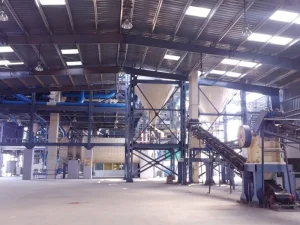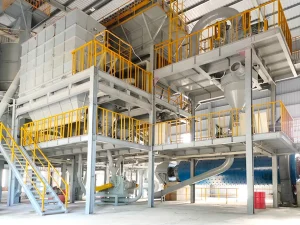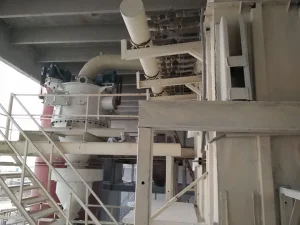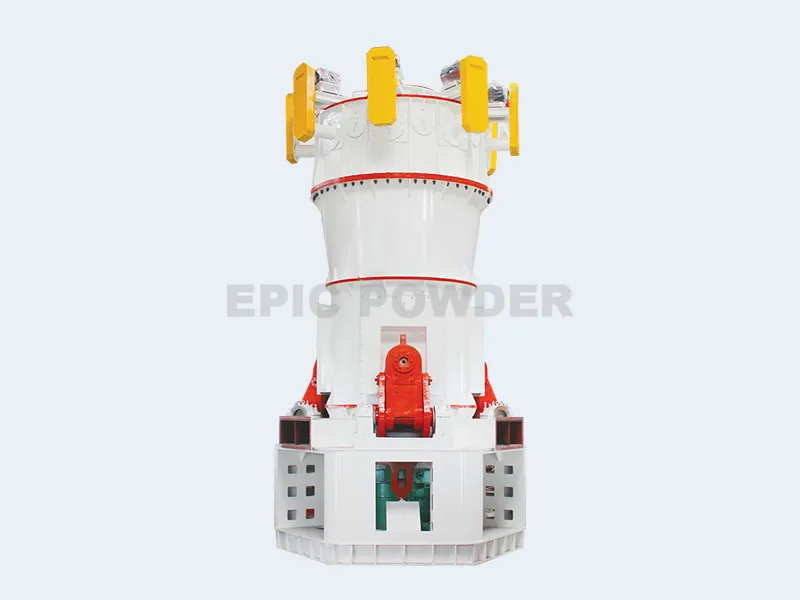
Table Roller Mill - Vertical Mill
The ultra-fine vertical mill is currently the super-large ultra-fine grinding equipment in Asia, which has been successfully applied in the market and has mature technology. It can replace imported equipment and is an ideal equipment for large-scale production of ultrafine powder with high efficiency, high yield, environmental protection and energy saving.
It is suitable for superfine grinding of non-metallic minerals such as calcium carbonate superfine powder, limestone, barite, calcite, kaolin, gypsum, pyrophyllite and graphite. It can provide high-quality fillers and additives for industries such as papermaking, plastics, coatings, rubber inks, and chemicals.
Table Roller mill working principle
The motor drives the reducer. In the mill, material falls from the feed opening onto a grinding disc. It moves to the edge of the mill due to centrifugal force and the grinding roller. Shredded material overflows from the edge. At the same time, wind from the nozzle ring speeds to the efficient separator. It is with the vertical mill. After the separator, meal returns to the mill wheel and grinds again. The fine powder is ground with the air flow. It collects in the system’s dust collector, which is the product. Larger granular materials don’t get picked up by the hot gas flow and metal parts accidentally get in. They sink from the wind ring and are scraped out by the scraper. Then, they circulate back into the grinding for grinding again.
Understand the internal structure and functions of Table Roller Mill
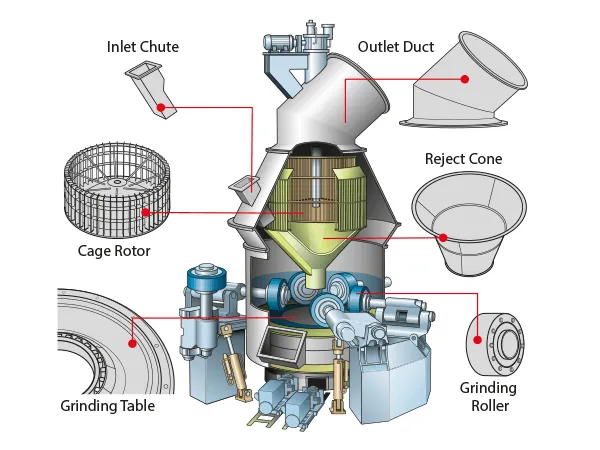
Table roller mills operate by pressure comminution. They are suitable for brittle but elastic feeds. The product is crushed by compressive stress. This stress comes from the grinding table and the grinding rollers. The specific grinding force is the contact force divided by the roller’s area. It is in the range of about 0.5 and 1 N/mm², whereby the effective pressures in the material bed are naturally much higher. A motor and gear unit set the grinding table spinning. They use peripheral speeds of 2 to 6 m/s. The gear unit has to absorb the forces of the grinding rollers. So, it has an axial friction bearing (segmented bearing).
The product is fed to the center of the grinding table. Centrifugal force conveys it across the table to the edge. The grinding rollers roll over the product repeatedly during this time and crush it. The rollers are pressed against the table by hydraulics. The table buffers the operation’s fluctuations. It does this with a hydraulic gas accumulator. The accumulator is charged with compressed air. The grinding table has a weir at its edge. You can choose the height of the weir to set how long the product stays in the grinding zone. A nozzle ring is located around the grinding table from which the incoming air exits at high speed. The broken-up product is carried up to the built-in air classifier. The rejected coarse material goes back to the grinding table for more breaking. The end product is separated from the air in a downstream collection unit.
Features of Table Roller mill
1.High grinding efficiency.
The roller sleeve and liner grinding curve specially designed for ultra-fine powder grinding makes it easier to form a material layer, with high grinding efficiency and high yield of one-time grinding.
2.High productivity and energy saving
The production capacity of a single machine is large, and the output is as high as 50t/h, which is equivalent to more than 5 micro-powder mills. It can save energy by 30-50% compared with ordinary mills to produce products with the same fineness.
3.Low operation and maintenance cost
The grinding roller can be turned out of the machine by hydraulic device, which is convenient for maintenance. Grinding roller sleeves can be turned over for use, prolonging the service life of wear-resistant materials, with low wear and tear. Grinding rollers and grinding disc liners are made of special materials, with long service life.
4.Low noise and environmental protection
The whole system has small vibration and low noise. It adopts an overall sealed negative pressure operation system and an air box pulse dust removal system. There is no dust spillage, and a dust-free workshop can basically be realized.
5.High degree of automation
It adopts PLC automatic control system and can realize remote control, which is easy to operate, easy to maintain and reduce labor costs.
6.Product quality is stable
The material stays in the mill for a short time, reducing repeated grinding, and the finished product has less iron content, high whiteness and purity, uniform particle shape, narrow particle size distribution, small cut point, good fluidity and strong adaptability.
7.Product quality is stable
The material stays in the mill for a short time, reducing repeated grinding, and the finished product has less iron content, high whiteness and purity, uniform particle shape, narrow particle size distribution, small cut point, good fluidity and strong adaptability.
8.Low comprehensive investment cost
Integrating crushing, drying, grinding, grading, and conveying, the process flow is simple, the structure layout is compact, and the floor space is small, only 50% of the ball mill. It can be arranged in the open air, the construction cost is low, and the investment cost is directly reduced.
Application fields of Table Roller Mill
Table roller mills are robust and time-proven mills for soft to medium-hard mineral raw materials and industrial bulk materials. The advantages of the table roller mill are the simple fineness adjustment and fast product change. Table roller mills are used wherever a high degree of production flexibility is demanded, for example for:
- Limestone
- Gypsum
- Dolomite
- Talc
- Petroleum coke
- Bentonite
- Quick lime
Related cases
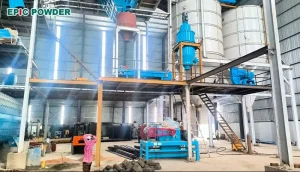
Ball Mill & Air Classifier Production Line +Pin Mill Surface Coating System Installation Site in Indian
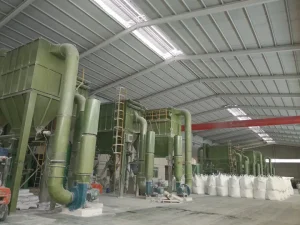
Barite powder SRM ultra-fine ring roller mill production line
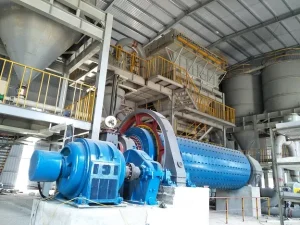
Grinding and classifying system for the production of calcium carbonate
